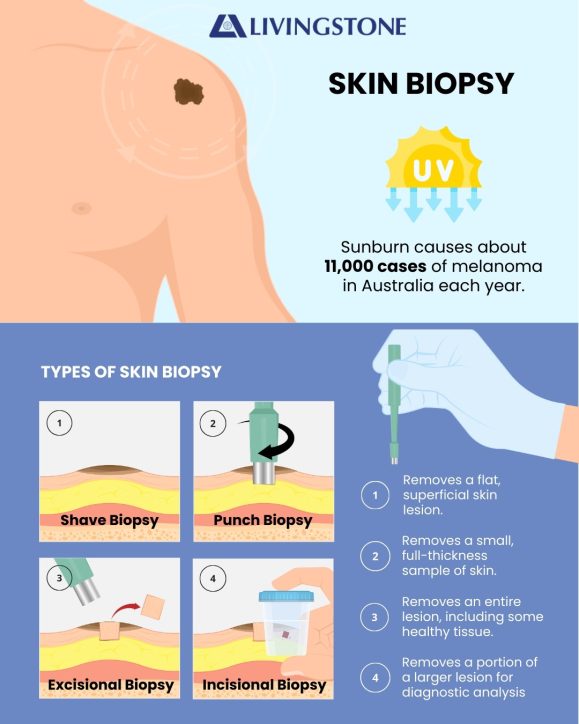A skin biopsy is a common yet vital procedure in modern medicine, helping doctors diagnose and monitor a wide range of skin conditions. While the idea of a biopsy can feel daunting, the process is straightforward and often performed in outpatient settings with minimal discomfort. Whether to confirm a diagnosis, rule out cancer, or evaluate persistent rashes, skin biopsies remain one of the most accurate tools for understanding what lies beneath the surface of the skin.
Why and When is a Skin Biopsy Performed?
Doctors recommend a skin biopsy when visual examination alone is not enough to provide a clear diagnosis. It may be carried out to investigate:
- Suspicious moles or growths that could be skin cancer
- Inflammatory conditions such as psoriasis or eczema
- Persistent infections, rashes, or unexplained skin lesions
- Autoimmune conditions that affect the skin

By removing a small sample of skin tissue, clinicians can examine it under a microscope to detect abnormal cells or underlying causes. According to the Cancer Council Australia, skin cancer is the most common cancer in the country, making early detection through biopsy a critical step in prevention and treatment.
What is Punch Biopsy Excision?
One of the most widely used biopsy methods is the punch biopsy, sometimes referred to as a punch excision. This technique involves using a small circular blade, similar to a miniature cookie cutter, to remove a cylindrical piece of skin that includes all layers from the epidermis down to the fat.
Punch biopsy excision is particularly effective for sampling rashes or inflammatory conditions, as it collects a full-thickness specimen that allows pathologists to see how the skin layers are affected. The site is usually closed with a single stitch or allowed to heal naturally, depending on the size of the sample. Clinics such as Rejuvence Clinic describe the method as both efficient and minimally invasive, with patients often returning to normal activities the same day.
Healing After a Skin Biopsy
Recovery from a skin biopsy is usually quick, but proper aftercare is essential to avoid infection and minimise scarring. Typical aftercare advice includes:
- Keep the area clean and dry for the first 24 hours
- Apply an antibiotic ointment and cover with a sterile bandage
- Change the dressing daily or as directed by your doctor
- Avoid swimming, saunas, or soaking the area until fully healed
- Monitor for redness, swelling, or discharge, which could signal infection
Most biopsy sites heal within one to two weeks, though deeper samples may take longer. Patients with stitches are generally advised to return for removal within 7–14 days. Scars are usually small and fade over time, particularly when wounds are protected from sun exposure.
Which Biopsy is the Most Painful?
Pain perception during a biopsy depends on the method used, the size of the sample, and the location of the procedure. Local anaesthetic is almost always administered, so discomfort is usually limited to a brief sting during injection.
Shave biopsies, which remove only the top layer of skin, are often reported as the least painful. Punch biopsies and excisional biopsies, which remove deeper layers, can cause mild soreness afterwards, especially in sensitive areas like the face or scalp. However, most patients describe the overall experience as more uncomfortable than painful, with lingering tenderness rather than sharp pain.
Biopsy vs Puncture: Understanding the Difference
While both terms are used in medical practice, a biopsy and a puncture serve different purposes.
- Biopsy refers specifically to the removal of a tissue sample for microscopic analysis. It is diagnostic in nature, helping identify diseases or abnormalities.
- Puncture generally refers to creating a small opening with a needle or sharp instrument to access fluid or relieve pressure. For example, a lumbar puncture collects cerebrospinal fluid, while a needle aspiration puncture may be used to drain fluid-filled cysts.
In short, a biopsy is about sampling tissue for diagnosis, whereas a puncture is about accessing or releasing fluid.
Final Thoughts
A skin biopsy is a safe and effective tool that gives clinicians vital insight into skin health. From identifying suspicious moles to clarifying chronic skin conditions, it provides clarity when visual checks are not enough. With techniques like punch biopsy excision, the procedure is quick, minimally invasive, and usually heals without complication.
Understanding what to expect, how to care for the biopsy site, and the difference between a biopsy and a puncture helps ease anxiety and ensures a smoother recovery. If you are scheduled for a skin biopsy, rest assured it is a routine part of dermatological care that plays a powerful role in early detection and effective treatment.
